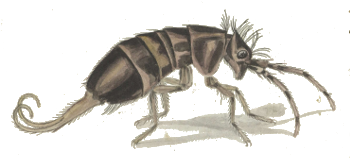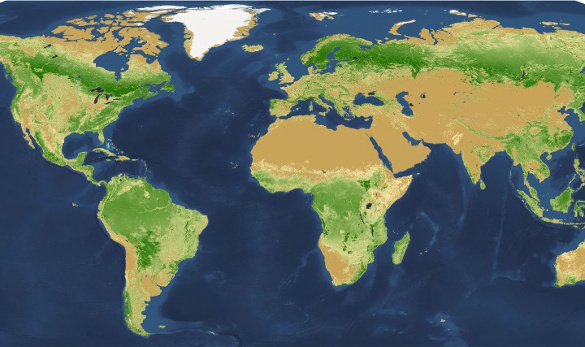A Multitude of Trees
September 21, 2015
Scientific articles in the
popular press are rare, so you can be sure that it's a "
slow news day" when you read an article about how
insects greatly outnumber
humans on
Earth. A good
estimate, based on several
published papers, is that there are 10
19 insects (10 billion billion) representing about 1-2 million
species.[1]
The number of insect species can only be estimated, and it may run up to 30 million. With slightly less than 10 billion
humans on our planet (10
10), the insects outnumber us by at least a billion to one. I'm starting to
itch.

Illustration of a Dutch East Indies "glimwormen" by Jan Brandes (1743-1808)
(Rijksmuseum Collection, via Wikimedia Commons.)
While 10 billion billion insects is a large number, the number of
bacteria on Earth is much larger. A recent estimate has 2.9 x 10
29 single-celled organisms (prokaryotes) living in
ocean sediments, which is about 10 billion billion bacteria per human.[2-3] The number of bacteria in
soil could be ten times this number.
The relative numbers of
macro-sized humans,
millimeter-sized insects, and
micro-sized bacteria suggest the existence of some
biological principle. It's
found that that small organisms have a greater number of species than large organisms, and this may influence the total number of individuals.

Biosafety level 4, 17th century style.
This costume, as described by Jean Jacques Manget (1652-1742) in his Traité de la peste (Treatise on the plague), was worn by physicians who attended plague patients in the 17th century.
The bird beak acted as a filter.
(Via Wikimedia Commons.)
One problem involved in an estimate of the number of a particular species is
sampling bias. When I look outside my
window, I see a
hillside with hundreds of
trees. A
desert-dweller, however, would see few, if any, trees. So, how many trees are there in the world? This is an important question, since trees act as a significant
carbon sink in our
environment.
This
biosequestration of carbon reduces
atmospheric greenhouse gas, but the effect is not as complete as what we would desire. The
US Environmental Protection Agency found that in 2013 US
forests sequestered only 10% of the 6,673 million
metric tons of
carbon dioxide released by
fossil fuel combustion in the
United States.[4]
Although it's still unclear how many
scientists it takes to change a
light bulb, we now know how many it takes to
count trees: 38. That's the number of
authors of a recent paper in
Nature describing the most accurate estimate of tree number to date.[5-8] The number found, 3.04 trillion, is an
order of magnitude higher than previous estimates.[5] The breakdown of trees by
habitat is about 1.39 trillion in
tropical and
subtropical forests, 0.74 trillion in
boreal regions, and 0.61 trillion in
temperate regions.[5-6]
There's a
joke that the definition of a
virgin forest is a forest where the "hand of man has never set foot." This study shows that the hand of man has been very active since the start of
civilization. It estimates that the number of trees today is only about 54% of the number at the start of civilization, and we are presently felling more than 15 billion trees each year, although about 5 billion are
replanted.[5-8]

Once a familiar scene, now typically a vacation photo opportunity.
Entrée du bois à Ville-d'Avray (Entrance to the Wood at Ville-d'Avray), oil on canvas painting, c. 1825, by Jean-Baptiste-Camille Corot (1796–1875).
(Scottish National Gallery accession number NG 1681, purchased with the aid of A E Anderson in memory of his brother Frank 1927, via Wikimedia Commons.)
This project was launched two years ago at the request of the group in charge of the
United Nations "
Billion Tree Campaign." The group wanted an estimate of tree number so it could set goals and evaluate its progress in
reforestration. Says lead author,
Thomas Crowther, a
postdoctoral fellow at the
Yale School of Forestry & Environmental Studies,
"Trees are among the most prominent and critical organisms on Earth... Yet you ask people to estimate, within an order of magnitude, how many trees there are and they don't know where to begin. I don't know what I would have guessed, but I was certainly surprised to find that we were talking about trillions."[6]
The best previous estimate of tree number, 400 billion trees, or about 61 trees per person, was far less than what was found.[6] That estimate was made solely through
satellite imagery without
ground observations.[6] The new estimate of 3.04 trillion corresponds to 420 trees per person.[7-8]
The study used a combination of satellite imagery and tree
density information from more than 400,000 forest plots to obtain data for
supercomputer modeling.[6] Satellite imagery, while good for showing forest extent, can't count the number of individual trees beneath the
forest canopy, thus the need for ground observation.[8] The result was a global map of tree density with
square-kilometer resolution.[6]

This global map of forest density, resolved at the square-kilometer level, was made from data derived from a combination of satellite imagery, forest inventories, and supercomputer modeling. (Yale University image by Crowther, et al.)[6)]
This more accurate estimate of tree number will have application in many
environmental areas, such as assessment of
animal and
plant habitats, and for
climate models relating to the removal of carbon dioxide from the atmosphere.[6,8] Although the number of trees has "increased," Crowther cautions that nothing has really changed. These trees have always been there. It's just our estimate of their numbers that's changed.[8]
References:
- Numbers of Insects (Species and Individuals), Encyclopedia Smithsonian.
- Jens Kallmeyera, Robert Pockalnyc, Rishi Ram Adhikari, David C. Smith, and Steven D'Hondt, "Global distribution of microbial abundance and biomass in subseafloor sediment," Proc. Natl Acad. Sci., vol. 109, no. 40 (October 2, 2012) http://dx.doi.org/10.1073/pnas.1203849109.
- Kathryn Lougheed, "There are fewer microbes out there than you think," Nature News, August 27, 2012.
- U.S. Greenhouse Gas Inventory Report: 1990-2013, US Environmental Protection Agency.
- T. W. Crowther, H. B. Glick, K. R. Covey, C. Bettigole, D. S. Maynard, S. M. Thomas, J. R. Smith, G. Hintler, M. C. Duguid, G. Amatulli, M.-N. Tuanmu, W. Jetz, C. Salas, C. Stam, D. Piotto, R. Tavani, S. Green, G. Bruce, S. J. Williams, S. K. Wiser, M. O. Huber, G. M. Hengeveld, G.-J. Nabuurs, E. Tikhonova, P. Borchardt , et al., "Mapping tree density at a global scale," Nature, Published online September 2, 2015, doi:10.1038/nature14967.
- Kevin Dennehy, "F&ES Study Reveals There are Many More Trees Than Previously Believed," Yale University Press Release, September 2, 2015.
- 'Three trillion' trees on Earth, BBC, September 3, 2015.
- Jonathan Amos, "Earth's trees number 'three trillion'," BBC News, September 3, 2015.
Permanent Link to this article
Linked Keywords: Science; scientific; mass media; popular press; slow news day; insect; human; Earth; approximation; estimate; scientific literature; published paper; species; world population; itch; Dutch East Indies; Rijksmuseum; Jan Brandes (1770 - 1787); Wikimedia Commons; bacteria; Prokaryote; single-celled organism; ocean; sediment; soil; macroscopic scale; millimeter-sized; microscopic scale; micro-sized; biology; biological; principle; body size and species richness; Biosafety level 4; costume; Jean Jacques Manget; physician; plague; patient; 17th century; bird beak; filter; sampling bias; window; hillside; tree; desert-dweller; carbon sink; environment; biosequestration of carbon; atmospheric greenhouse gas; United States Environmental Protection Agency; forest; metric ton; carbon dioxide; fossil fuel; combustion; United States; scientist; light bulb; counting; count; author; Nature; order of magnitude; habitat; tropics; tropical; subtropics; subtropical; Taiga; boreal region; temperate climate; temperate region; joke; old-growth forest; virgin forest; civilization; reforestation; replant; vacation; photo opportunity; oil on canvas painting; Jean-Baptiste-Camille Corot (1796–1875); Scottish National Gallery; United Nations; Billion Tree Campaign; Thomas Crowther; postdoctoral research; postdoctoral fellow; Yale School of Forestry & Environmental Studies; satellite imagery; ground observation; area density; >supercomputer; mathematical model; modeling; forest canopy; square-kilometer; image resolution; resolved; data; forest inventory; animal; plant; climate model.